Artificial intelligence (AI) is rapidly becoming a part of everyday life, seamlessly integrating into both professional and personal activities across a wide range of industries. A key area of this growth has been in voice-activated technology. Voice assistants, for instance, are now embedded into most devices, smartphones, and even work equipment. It’s estimated that approximately 50% of the worldwide population utilizes voice-controlled systems, highlighting how essential these tools have become in both personal and professional settings.
Despite significant advancements in AI and speech recognition, these technologies continue to face a persistent challenge: performing accurately in noisy environments.

The challenge of distinguishing between speaker commands and background noise often leads to misunderstandings or failures in task execution. This not only causes frustration for users but also limits the clarity, functionality, and reliability of voice-controlled devices. Such obstacles emphasize the urgent need to adapt voice AI to varying noise levels, particularly in work environments where clear communication is crucial for safety and efficiency.
What’s at Stake?
Noisy environments can significantly reduce the performance of voice AI systems. Challenging acoustic settings, such as construction sites, hospitals, manufacturing facilities, and busy offices, present a considerable hurdle for users of voice-activated devices. These environments are filled with background noise that interferes with the voice recognition system’s ability to accurately interpret speaker commands.
Although modern speech recognition systems can reach up to 97% accuracy in optimal, quiet conditions, the accuracy drops substantially in high-noise environments. The system’s difficulty lies in separating the user’s speech from the surrounding sounds. For instance, a construction worker trying to control machinery using voice commands in the middle of a bustling job site may experience command misinterpretation or failure, as the system struggles to distinguish their voice over the sounds of drills, engines, and other machinery.
These challenges are more than just technical inconveniences. In high-stakes environments like healthcare or emergency services, misinterpreting a voice command can lead to serious, and potentially dangerous, consequences.
For example, if a voice-activated system in an operating room fails to properly execute a command because of surrounding conditions, the delay or mistake could hinder patient care. Similarly, in industrial settings, a misinterpreted command could result in operational inefficiencies or even accidents, leading to potential harm.
This issue goes beyond the realm of convenience—it’s a matter of operational safety and effectiveness. Therefore, tackling the challenge of voice recognition in noisy environments is a top priority for professionals across a wide range of industries.
How Can These Issues Be Overcome?
To address these pressing issues, advanced speech enhancement, also referred as noise-cancellation techniques are being developed and integrated into command systems. These technologies are specifically designed to improve the clarity and intelligibility of inputs in a loud environment. By functioning as an audio filter, these techniques minimize background noise while amplifying and refining the signals that the system is meant to process. This ensures that commands are accurately interpreted by the device, even in loud or chaotic settings.

At Vivoka, we work in collaboration with BdSound, their expertise makes our technologies even more accurate and powerful than it was.
The underlying principle of speech enhancement technology is to create a higher signal-to-noise ratio, meaning it strengthens the desired speech signal while simultaneously reducing unwanted ambient sounds. By reducing acoustic interference, these systems significantly enhance the accuracy of voice command processing, improving both the speaker experience and the reliability of the system.
Several methods are used to achieve this enhancement. Noise-cancellation algorithms, for instance, actively detect and remove surrounding sounds that are not associated with the user’s voice. Deep learning models can also be employed, allowing the system to learn and adapt to noisy areas by identifying patterns in both speech and noise. Speech enhancement, when combined with voice biometrics, enhances the audio signals, and therefore improves the ability to authenticate a specific user’s voice, even in situations where multiple people are speaking at the same time.
Positive Impacts of Speech Enhancement

The integration of speech enhancement into voice command systems offers a wide range of benefits that extend beyond just noise reduction. By improving the overall accuracy and responsiveness, speech enhancement is poised to revolutionize the application of voice AI across multiple industries.
Below are some of the key advantages:
1. Increased Productivity
In environments where noise is unavoidable, such as construction sites, warehouses, or hospitals, speech enhancement allows workers to continue their tasks without being impeded by background noise. This capability is particularly valuable in fast-paced, hands-on professions where employees often need to control machinery, access data, or issue commands while keeping their hands free.
For example, a construction worker managing heavy machinery with voice commands can maintain workflow without having to pause or repeat themselves due to poor speech recognition. The clearing audio minimizes interruptions, reduces downtime, and ultimately boosts productivity. Workers can complete tasks more efficiently, even in a challenging environment where traditional methods of interaction might fail.
2. Enhanced Safety
Safety is a key priority in industries like healthcare, construction, and manufacturing. In these sectors, clear and precise communication is critical to preventing accidents and ensuring that tasks are performed correctly. Speech enhancement technology reduces the likelihood of misunderstandings caused by background noise, allowing voice commands to be heard and executed accurately.
In healthcare settings, where split-second decisions can mean the difference between life and death, having a speech-activated system that works reliably in noisy settings can be invaluable. For instance, in a busy emergency room or operating theater, speech enhancement can ensure that critical instructions are understood and followed, improving the safety and quality of care provided to patients.
Similarly, in high-risk industrial settings, voice commands need to be executed flawlessly to avoid mishaps. Speech enhancement technology provides an additional layer of security by making sure that voice AI systems function reliably.
3. Improved User Experience
Users don’t have to repeat commands multiple times or adjust their environment just to get their device to understand them. This ease of use significantly elevates the user experience, making voice-activated solutions more intuitive, accessible, and enjoyable to interact with.The reduced friction in human-device interaction can also drive broader adoption of voice technologies in everyday work life, as workers become more confident in their reliability.
4. Multitasking and Hands-Free Operation
In many professional settings, the ability to multitask is essential for maintaining efficiency. Field workers often need to interact with devices while performing physical tasks. Voice AI facilitates this by allowing them to give commands without having to stop their work, but in noisy environments, this can become challenging. This noise cancellation technology allows workers to focus on their tasks without worrying about whether the machine will correctly understand their commands, which is utterly relevant for some professions.
5. Why choosing Vivoka Speech Enhancement
Vivoka Speech Enhancement technology stands out from the others for its offline capability, which is a crucial advantage in sectors where constant connectivity isn’t guaranteed or desirable for security reasons, such as in the healthcare domain. But this offline asset also represents data privacy since it cannot be stored on any servers. By enabling highly accurate speech recognition without relying on an internet connection, our solution offers unparalleled reliability in diverse, often noisy, environments.
Whether it’s in factories, hospitals, or offices, it will ensure optimal performance while adapting to the specific constraints of each setting. This makes it a strategic tool for industries requiring both precision and offline functionality, delivering consistent results wherever it’s needed most.



